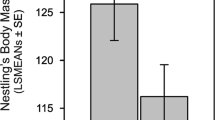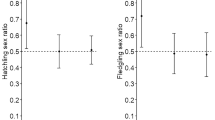Abstract
Previous research has suggested that parental condition may affect offspring mortality patterns by affecting offspring testosterone levels. Accordingly, we hypothesized that there is a relationship between offspring testosterone concentration and survival during the early nestling period, and that both are influenced by parent age/experience and by prey availability. We tested our hypothesis on tawny owls Strix aluco in their first and third known breeding seasons, when they bred either in adverse or mild weather conditions, in Duna-Ipoly National Park, Hungary. Plasma testosterone concentrations of the nestlings were analyzed and related to parental condition, hatching order and nestling mortality. Inexperienced parents breeding in all weather conditions and experienced parents breeding in adverse conditions were both in poor condition compared to experienced parents breeding in mild conditions. Parents in poor condition produced broods with large between-sibling differences in testosterone concentrations and their later-hatched nestlings (which had low testosterone levels) died during the early nestling period, whereas parents in good condition produced broods with lower variation in offspring testosterone concentrations and all offspring survived the early nestling period. We discuss environmental influences on the amount of testosterone deposited in eggs, and also how maternal testosterone might induce those mechanisms producing testosterone in the nestlings.
Similar content being viewed by others
References
Adkins-Regan E, Ottinger MA, Park J (1995) Maternal transfer of estradiol to egg yolks alters sexual differentiation of avian offspring. J Exp Zool 271:466–470
Andrew RJ (1975a) Effects of testosterone on the behaviour of the domestic chick: I. Effects present in males but not in females. Anim Behav 23:139–155
Andrew R J (1975b) Effects of testosterone on the behaviour of the domestic chick: II. Effects present in both sexes. Anim Behav 23:156–168
Clark AB, Wilson DS (1981) Avian breeding adaptations: hatching asynchrony, brood reduction, and nest failure. Q Rev Biol 56:253–277
Clifton PG, Andrew RJ, Brighton L (1988) Gonadal steroids and attentional mechanism in young domestic chicks. Physiol Behav 43:441–446
Coulson JC (1968) Differences in the quality of birds nesting in the centre and on the edges of a colony. Nature 217:478–479
De Steven D (1978) Clutch size, breeding success and parental survival in the tree sparrow (Iridoprocne bicolor). Evolution 34:278–291
Eising CM, Eikenaar C, Schwabl H, Groothuis TGG (2001) Maternal androgens in black-headed gull (Larus ridibundus) eggs: consequences for chick development. Proc R Soc Lond B 268:839–846
Fowler GS, Wingfield JC, Boersma PD, Sosa, RA 1994. Reproductive endocrinology and weight change in relation to reproductive success in the Magellanic penguin (Spheniscus magellanicus). Gen Comp Endocr 94:305–315
Gibbons DW (1987) Hatching asynchrony reduces parental investment in the jackdaw. J Anim Ecol 56:403–414
Groothuis T, Meeuwissen G (1992) The influence of testosterone on the development and fixation of the form of display in two age classes of young black-headed gulls. Anim Behav 43:189–208
Ketterson E, Nolan V (1999) Adaptation, exaptation, and constraint: a hormonal perspective. Am Nat 154:343–348
Korpimäki E. (1988) Effects of age on breeding performance of Tengmalm’s Owl Aegolius funereus in western Finland. Ornis Scand 19:21–26
Lack D (1954) The natural regulation of animal numbers. Clarendon Press, Oxford
Lipar JL, Ketterson E (2000) Maternally derived yolk testosterone enhances the development of the hatching muscle in the red-winged blackbird Agelaius phoeniceus. Proc R Soc Lond B 267:2005–2010
Magrath RD (1989) Hatching asynchrony and reproductive success in the blackbird. Nature 339:536–538
Massa R, Bottomi L (1987) Effect of steroidal hormones on locomotory activity of the male chaffinch (Fringilla coelebs L.). Mon Zool Ital NS 21:69–76
Nuñez-de la Mora F, Delamone AN, Drummond H, Wingfield JC (1996) Hormonal correlates of dominance and starvation-induced aggression in chicks of the blue-footed bobby. Ethology 102:748–761
Orians GH (1969) Age and hunting success in the Brown Pelican (Pelecanus occidentalis). Anim Behav 17:316–319
Péczely P, Pethes G, Rudas P (1980) Interrelationship between thyroid and gonadal function in female Japanese quail kept under short and long photoperiods. J Endocrinol 87:55–63
Petty SJ (1992) A guide to age determination of Tawny Owl Strix aluco. In: Galbraith CA, Taylor IR, Percival S (eds) The ecology and conservation of European owls. ) Joint Nature Conservation Committee, Peterborough, UK, pp 89–91
Pianka ER (1976) Natural selection of optimal reproduction tactics. Am Zool 16:775–784
Pugesek BH, Diem KL (1983) A multivariate study of the relationship of parental age to reproductive success in California gulls. Ecology 64:829–839
Richter W (1982) Hatching asynchrony: the nest failure hypothesis and brood reduction. Am Nat 120:828–832
Ros AFH, Groothuis TGG, Apanius V (1997) The relation among gonadal steroids, immunocompetence, body mass, and behavior in young black-headed gulls (Larus ridibundus). Am Nat 150:201–219
Ros AFH, Hirschenhauser K, Oliveira RF (2001) The interaction between organizational and activational effects of testosterone in the control of early aggression in birds: a reply to Sasvári, Hegyi & Péczeli. Ethology 107:851–853
Royle NJ, Surai PF, McCartney RJ, Speake BK (1999) Parental investment and egg yolk lipid composition in gulls. Funct Ecol 13:298–306
Royle NJ, Surai PF, Hartley IR (2001) Maternally derived androgens and antioxidants in bird eggs: complementary but opposing effects? Behav Ecol 12:381–385
Sasvári L, Hegyi Z, Péczely P (1999) Brood reduction in white storks mediated through asymmetries in plasma testosterone concentrations in chicks. Ethology 105:569–582
Sasvári L, Hegyi Z, Csörgő T, Hahn I (2000) Age-dependent diet change, parental care and reproductive cost in tawny owls Strix aluco. Acta Oecol 21:267–275
Schantz T von, Bensch S, Grahn M, Hasselquist D, Wittzell H (1999) Good genes, oxidative stress and condition-dependent sexual signals. Proc Royal Soc London, Ser B 266:1–12
Schüz E (1984) Über Syngenophagie, besonders Kronismus. Ein beiträg zur Ethologie Speziell des Weissstorchs. Ökol Vögel 6:141–158
Schwabl H (1993) Yolk is a resource of maternal testosterone for developing birds. Proc Natl Acad Sci USA 90:11449–11450
Schwabl H (1996) Maternal testosterone in the avian egg enhances postnatal growth. Biochem Physiol 114A:271–276
Slagsvold T (1986) Asynchronous versus synchronous hatching in birds: experiments with pied flycatcher. J Anim Ecol 44:1115–1134
Thomas CS, Coulson JC (1988) Reproductive success of kittiwake gulls, Rissa tridactyla. In: Clutton-Brock TH (ed) Reproductive success: studies of individual variation in contrasting breeding systems. Universitiy of Chicago Press, Ill., pp 251–262
Tortosa FS, Redondo T (1992) Motives for parental infanticide in white storks Ciconia ciconia. Ornis Scand 23:185–189
Wada M (1982) Effects of sex steroids on calling, locomotory activity, and sexual behavior in castrated male Japanese quail. Horm Behav 16:147–157
Wada M (1986) Circadian rhythms of testosterone-dependent behaviors crowing and locomotory activity in male Japanese quail. J Comp Physiol 158:17–25
Wingfield JC, Farner DS (1993) Endocrinology of reproduction in wild species. In: Farner DS, King JR, Parkes KC (eds) Avian biology, vol 9. Academic Press, New York, pp 163–327
Wingfield JC, Hegner RE, Dufty AM, Ball GF (1990) The ‘challenge hypothesis’: Theoretical implications for patterns of testosterone secretion, mating systems, and breeding strategies. Am Nat 136:829–846
Winkler DW (1993) Testosterone in egg yolks: an ornithologist’s perspective. Proc Natl Acad Sci USA 90:11439–11441
Acknowledgements
We are indebted to Dr. Webster and anonymous referees for their constructive comments and suggestions. We appreciate the improvements in English usage made by Robert A. James through the Association of Field Ornithologists’ program of editorial assistance. This work was supported by the Department of Zoology, Eszterházy Károly College of Education, Eger, and Hungarian National Foundation for Scientific Research (project number: T 37388). We also are grateful to the Frank M. Chapman Memorial Fund, the American Museum of Natural History, New York, for its financial support.
Author information
Authors and Affiliations
Corresponding author
Additional information
Communicated by M. Webster, T. Czeschlik
Rights and permissions
About this article
Cite this article
Sasvári, L., Péczely, P. & Hegyi, Z. The influence of parental age and weather on testosterone concentration and offspring survival in broods of tawny owl Strix aluco . Behav Ecol Sociobiol 56, 306–313 (2004). https://doi.org/10.1007/s00265-004-0788-3
Received:
Revised:
Accepted:
Published:
Issue Date:
DOI: https://doi.org/10.1007/s00265-004-0788-3




